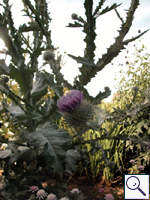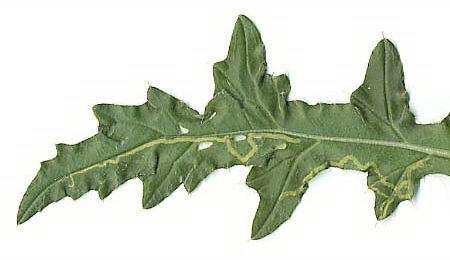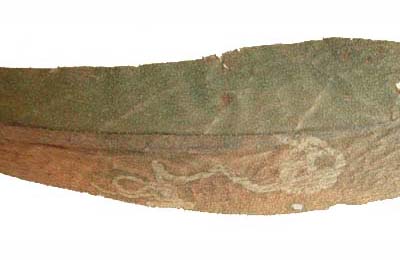|
||||||
|
ONOPORDUM. Cotton thistle. [Asteraceae] |
|
|
Five species of Onopordum are recorded in Britain. These include the native Cotton thistle (O. acanthinum). Five British miners is recorded on Onopordum. A key to the European miners recorded on Onopordum is provided in Bladmineerders van Europa. |
 Cotton Thistle Onopordum acanthium |
Key for the identification of the known mines of British |
| 1a > Leaf-miner: A distinctive mine primarily above mid-rib, with irregular short lateral offshoots into leaf blade. Pupation external (Spencer, 1972: 51 (fig. 172), 55; Spencer, 1976: 270, 271 (fig. 486)). Branched, whitish, upper-surface corridor; main axis overlying the midrib; side branches overlying the main lateral veins. (In Campanula and Phyteuma the mine is much less branched, sometimes nothing more than a corridor on top of the midrib). Frass in rather long strings. Usually the mines begins as a long and narrow, shallow, tortuous lower-surface corridor that ends upon the midrib but otherwise is not associated with the leaf venation. Often this initial corridor is filled with callus, and then even less conspicuous. Pupation outside the mine. A linear mine on the upper surface, usually following the midrib and showing side branches along the veins. The frass is in strings. |
|
Liriomyza strigata (Meigen, 1830) [Diptera: Agromyzidae]. |
1b > Leaf-miner: Long narrow interparenchymal mine, greenish. Pupation in leaf at end of mine (Spencer, 1976: 503 (fig. 880)). Unusually long, interparenchymatous, therefore yellowish corridor that remains of equal width throughout its length. (In some plants with thin leaves, like Cirsium oleraceum the mines are not interparechymatous but either full-depth or alternating upper- and lower-surface). The mine makes few curves, and hardly any u-turn, causing the mine to usually occupy the entire length of a leaf. Frass in two rows of grains along the sides. Pupation within the mine, in a lower-surface puparial chamber; the anterior spiracles penetrate the epidermis. |
 Mines of Phytomyza spinaciae on Cirsium arvense Image: © Willem Ellis (Bladmineerders van Europa) |
|
Phytomyza spinaciae Hendel, 1928 [Diptera: Agromyzidae]. |
1c > Leaf-miner: Mine long, distinctly greenish. Pupation in mine (Spencer, 1972b: 88). Branched, upper-surface corridor, with very irregular sides. Frass in isolared grains, maximally only 4 times their diameeter apart. Pupation within the mine. |
 Mine of Phytomyza autumnalis on Centaurea nigra (Spencer Collection) Image: © Brian Pitkin |
|
Phytomyza autumnalis Griffiths, 1959 [Diptera: Agromyzidae]. |
| 1d > Long corridor, often following the leaf margin, with little frass and with the sides irrregularly eaten out. The first part of the corridor is full depth and makes a few close loops; the later part is more upper-surface and rather wide. Primary feeding lines often conspicuous. No morphological differences are known between the larva of S. rubidum and S. testaceum (Steinhausen, 1994a). However, there is a phenological difference: the larva of testaceum hibernates in the mine and continues feeding after winter; S. rubidum vacates the mine before winter and pupates in the soil. Hering (1957a) suggests that the identification of the beetles is an easy matter, but that is contradicted by Warchalowski (2003a). |
|
Sphaeroderma testaceum (Fabricius, 1775) [Coloeptera : Chrysomelidae]. |
1e > Long corridor mine, without obvious relation with the leaf margin, with little frass and irregularly eaten out sides. The first part of the mine is full depth and makes a few close loops; the second part is upper-surface and considerably wider. Primary feedings lines often obvious. The larva is so broad that is completely fills the mine. No morphological differences are known between the larvae of S. rubidum and those of S. testaceum (Steinhausen, 1994a). The larva leaves the mine to pupate in the soil (the larva of testaceum hibernates in the mine.) Hering (1957a) suggests that the imagines are easily separated, but this is contradicted by Warchalowski (2003a). |
|
Sphaeroderma rubidum (Graells, 1858) [Coloeptera : Chrysomelidae]. |
| Last updated 06-Jul-2019 Brian Pitkin | ||
